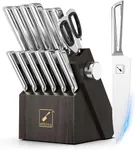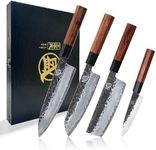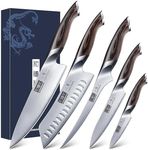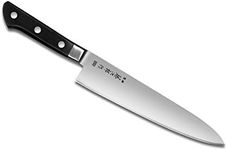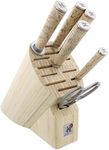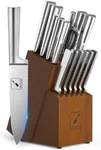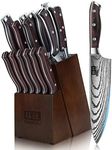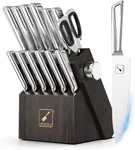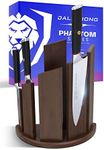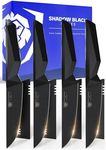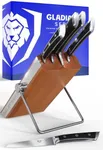Buying Guide for the Best Japanese Knife Sets
Choosing the right Japanese knife set can significantly enhance your cooking experience. Japanese knives are known for their precision, sharpness, and craftsmanship. When selecting a knife set, it's important to consider various factors to ensure you get the best fit for your needs. Here are some key specifications to help you make an informed decision.Blade MaterialThe blade material is crucial as it affects the knife's sharpness, durability, and ease of maintenance. Common materials include stainless steel, high-carbon steel, and Damascus steel. Stainless steel is resistant to rust and easy to maintain, making it suitable for everyday use. High-carbon steel is extremely sharp and holds its edge well but requires more care to prevent rust. Damascus steel is known for its beautiful patterns and combines the benefits of both stainless and high-carbon steel. Choose a material based on your willingness to maintain the knife and your preference for sharpness and durability.
Blade EdgeThe blade edge determines how the knife cuts and how often it needs sharpening. Japanese knives typically have a single bevel (sharpened on one side) or a double bevel (sharpened on both sides). Single bevel knives are extremely sharp and ideal for precise cuts, making them perfect for professional chefs or serious home cooks. Double bevel knives are more versatile and easier to use for general cooking tasks. Consider your skill level and the types of food you frequently prepare when choosing the blade edge.
Handle MaterialThe handle material affects the knife's comfort, grip, and overall balance. Common materials include wood, plastic, and composite. Wooden handles offer a traditional look and feel but may require more maintenance to prevent cracking. Plastic handles are durable and easy to clean, making them a practical choice for busy kitchens. Composite handles combine the benefits of both wood and plastic, offering durability and a comfortable grip. Choose a handle material that feels comfortable in your hand and suits your maintenance preferences.
Knife Types IncludedA Japanese knife set typically includes various types of knives, each designed for specific tasks. Common knives in a set include the Gyuto (chef's knife), Santoku (all-purpose knife), Nakiri (vegetable knife), and Petty (paring knife). Consider the types of food you cook most often and choose a set that includes the knives you will use regularly. If you frequently prepare vegetables, a set with a Nakiri knife might be beneficial. For general cooking, a set with a Gyuto or Santoku knife is essential.
Weight and BalanceThe weight and balance of a knife affect how it feels in your hand and how easy it is to use. Japanese knives are generally lighter and more balanced than Western knives, allowing for precise and controlled cuts. However, the ideal weight and balance can vary depending on personal preference. If you prefer a lighter knife for delicate tasks, look for a set with lighter blades. If you need more control and power, a slightly heavier knife might be better. Test the knives if possible to find the right balance for your comfort and cooking style.
Maintenance RequirementsMaintenance requirements include how often the knives need sharpening and how they should be cleaned and stored. High-carbon steel knives require regular sharpening and careful cleaning to prevent rust, while stainless steel knives are more forgiving and easier to maintain. Some knives may also need to be hand-washed and dried immediately to maintain their condition. Consider how much time and effort you are willing to invest in maintaining your knives and choose a set that fits your lifestyle.
